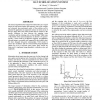Free Online Productivity Tools
i2Speak
i2Symbol
i2OCR
iTex2Img
iWeb2Print
iWeb2Shot
i2Type
iPdf2Split
iPdf2Merge
i2Bopomofo
i2Arabic
i2Style
i2Image
i2PDF
iLatex2Rtf
Sci2ools
ISCAS
2003
IEEE
2003
IEEE
A VLSI model of range-tuned neurons in the bat echolocation system
The neural computations that support bat echolocation are of great interest to both neuroscientists and engineers, due to the complex and extremely time-constrained nature of the problem and its potential for application to engineered systems. In various areas of the bat’s brain, there exist neural circuits that are sensitive to the specific difference in time between the outgoing sonar vocalization and the returning echo, or time-of-flight. While some of the details of the neural mechanisms are known to be speciesspecific, a basic model of re-afference triggered, post-inhibitory rebound timing is reasonably well supported by the available data. We have designed low-power neuromorphic VLSI circuits to mimic this mechanism and have demonstrated range-dependent outputs for use in a real time sonar system. These circuits are being used to implement range-dependent vocalization rates and amplitudes.
| Added | 04 Jul 2010 |
| Updated | 04 Jul 2010 |
| Type | Conference |
| Year | 2003 |
| Where | ISCAS |
| Authors | Matthew Cheely, Timothy K. Horiuchi |
Comments (0)

